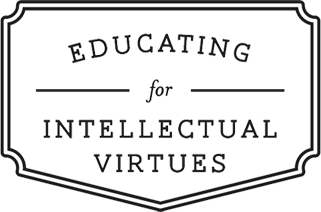
Core Practices
What follows is a brief overview of several classroom-based practices and strategies integral to educating for intellectual virtues. For a more in-depth discussion of these and other strategies, and for related resources, you can order Deep in Thought: A Practical Guide to Teaching for Intellectual Virtues.
Create a safe and supportive classroom environment
Educating for intellectual virtues is a matter of educating for deep personal growth. As such it involves a transformation of students’ fundamental beliefs, attitudes, and feelings about thinking and learning. Change of this sort does not occur in a vacuum. Rather, it occurs most readily in the context of trusting and caring relationships (Berkowitz and Bier 2006; Siegel 2012). Therefore, if we want our students to be open to revising their fundamental “habits of mind,” we must work hard to ensure that they feel respected and cared for—by us and by their peers. We must create a relationally-focused classroom environment in which all students anticipate feeling safe and supported.
“Educating for intellectual virtues is a matter of educating for deep personal growth. As such it involves a transformation of students’ fundamental beliefs, attitudes, and feelings about thinking and learning.”
Use direct instruction
Teaching students about intellectual virtues isn’t the most forceful or effective way of helping them grow in intellectual virtues. But it does occupy an important role within a comprehensive approach to intellectual character education (Perkins and Salomon 1989; Berkowitz and Puka 2009). By equipping students with an understanding of what intellectual virtues are and why they are important, we equip them with an important tool. Such understanding can make them more aware of opportunities to practice intellectual virtues and bolster their motivation to do so. Therefore, a certain amount of “direct instruction” in intellectual virtues—of teaching students what intellectual virtues are, how they differ from other intellectual and moral strengths, and why they are important for learning and living well—is an important pedagogical practice. (For materials useful in this context, see Chapter 5 of Deep in Thought: A Practical Guide to Teaching for Intellectual Virtues as well as these resources.)
Create opportunities to practice intellectual virtues
Psychologists, educational theorists, and philosophers agree that we grow in intellectual virtues in part by practicing the skills and abilities that define them. These include asking thoughtful and insightful questions, thinking for oneself, acknowledging one’s intellectual limitations and mistakes, probing for deeper understanding, noticing important details, considering alternative perspectives, persisting in the face of intellectual struggle, and taking intellectual risks. Therefore, an indispensable part of helping our students grow in intellectual virtues is creating consistent, well-supported opportunities for them to practice the virtues we have chosen to emphasize (Ritchhart et al 2011). Such opportunities can and should be built into all aspects of our courses: from in-class exercises to homework assignments to exams and papers.

Provide virtues-based feedback
The sorts of opportunities just described need to be followed up with meaningful virtues-based feedback (Ritchhart 2002). In other words, we need to give our students opportunities to practice intellectual virtues and provide them with input about these performances. Much of this feedback should be positive: we should praise students when we see them successfully practice a target virtue. But it can also be constructive: if done gently and respectfully, we can help students understand how they can improve. Virtues-based feedback can take many forms, including “noticing and naming” virtuous actions during class (“Jasmine, that was an excellent display of open-mindedness”), written comments on exams and papers, and grading rubrics that employ virtue-based criteria. The latter might ask whether the student or her work “explains the material in depth” (intellectual thoroughness), “avoids careless mistakes” (intellectual carefulness), “represents alternative perspectives accurate and fairly” (open-mindedness), “defends an original thesis” (intellectual autonomy), and so on.
“An intellectually virtuous person is not content with mere memorization or rote problem-solving. She wants to understand the things she is learning.”
Teach for deep understanding
An intellectually virtuous person is not content with mere memorization or rote problem-solving. She wants to understand the things she is learning (Baehr 2014). This is a function of her curiosity, thoroughness, and other habits of mind. Accordingly, educating for intellectual virtues requires teaching for deep understanding. It requires exploring ideas, asking questions, considering possibilities, and making connections (Leithwood 2006). It favors depth over breadth.
Draw attention to value and meaning
Educating for intellectual virtues also requires engaging students in meaningful intellectual activities—not with mere busywork or other “mindless” exercises. However, the meaningfulness or importance of such activities isn’t always apparent to students. Therefore, we need to regularly address and engage them in conversations about the value of what they are learning. This might involve pointing out how something they are learning will be useful to them in the “real world.” Or it might involve explaining why the relevant knowledge or skill is critical to living a good life (e.g. to making wise, well-grounded choices) or to becoming a certain type of person (e.g. one who is curious, thoughtful, open-minded, or intellectually courageous). Either way, taking time to draw attention to the meaning and value of what we are asking our students to do or learn can help boost their motivation to learn, which is a powerful catalyst to intellectual character growth.

Focus on risk-taking and failure
Many students suffer from a “fixed mindset.” These students fear failure and struggle, for they see these as an indication that they don’t have what it takes to succeed. This is a potentially debilitating intellectual stance. Thus we need to help our students develop a “growth mindset,” that is, a mindset that views growth and success as a real possibility—a possibility that often comes about through struggle, risk-taking, and even failure (Dweck 2006, 2010). We need to regularly take pains (in what we say and how we act) to help our students believe—and feel—that intellectual struggle and failure really are opportunities for growth. We need to value and create opportunities for them to take intellectual risks. Doing so is especially important to helping our students grow in virtues like intellectual humility, intellectual tenacity, and intellectual courage.
“We need to regularly take pains (in what we say and how we act) to help our students believe—and feel—that intellectual struggle and failure really are opportunities for growth. We need to value and create opportunities for them to take intellectual risks.”
Model intellectual virtues
Unsurprisingly, there is no substitute for modeling the kind of thinking and learning we are trying to foster in our students (Lickona 2004; Ritchhart 2015). A failure to do so is bound to undermine even our best efforts. It exposes us to charges of hypocrisy from our students. And who is interested in learning from a hypocrite? On the positive side, when we model qualities like curiosity, open-mindedness, intellectual humility, and intellectual thoroughness, we provide our students with a concrete and inspiring example of the kind of intellectual character we are inviting them to cultivate.
References
Baehr, Jason. 2014. “Sophia,” in Virtues and their Vices, eds. Kevin Timpe and Craig Boyd (Oxford University Press, 2014): pp. 303-323.,
Berkowitz, Marvin and Bill Puka. 2009. “Dissent and Character Education,” in Reclaiming Dissent: Civics Education for the 21st Century, ed. Mordechai Gordon (Rotterdam: Sense Publishers): pp. 107-30.
Berkowitz, Marvin and Melinda Bier. 2006. “What Works in Character Education: A Research-Driven Guide for Educators” (Washington, DC: Character Education Partnership).
Dweck, Carol. 2010. “Even Geniuses Work Hard,” Educational Leadership 68/1: pp. 16-20.
Dweck, Carol. 2006. Mindset: The New Psychology of Success (New York: Random House).
Leithwood, Kenneth, Pat McAide, Nina Bascia, Anne Rodrigue, eds. 2006. Teaching for Deep Understanding: What Every Educator Should Know (Thousand Oaks, CA: Corwin Press).
Lickona, Thomas. 2004. Character Matters: How to Help Children Develop Good Judgment, Integrity, and Other Essential Virtues (New York: Simon and Schuster).
Perkins, David and Gavriel Salomon. 1989. “Are Cognitive Skills Context-Bound,” Educational Researcher 18/1: pp. 16-25.
Ritchhart, Ron. 2015. Creating Cultures of Thinking: The Eight Forces We Must Master to Truly Transform Our Schools (San Francisco: Jossey-Bass).
Ritchhart, Ron. 2002. Intellectual Character: What It Is, Why It Matters, and How to Get It (San Francisco: Jossey-Bass).
Ritchhart, Ron, Mark Church, and Karin Morrison. 2011. Making Thinking Visible (San Francisco: Jossey-Bass).
Siegel, Daniel. 2012. The Developing Mind: How Relationships and the Brain Interact to Shape Who We Are, second edition (New York: Guilford Press).


